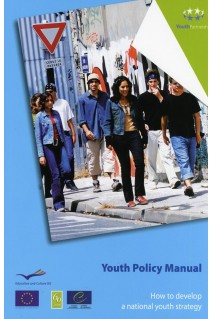



What is youth policy, and what major elements should a national youth policy strategy include? How can young people be consulted and otherwise involved in developing youth policy? How do institutions such as the European Union, the Council of Europe and the United Nations address youth policy, and how can this work be concretely linked to the efforts of a national government to develop a youth policy agenda?These are some of the essential questions addressed in this publication. The Youth Policy Manual should be considered a resource, a tool and a helpful guide both for policy makers in the youth field and for non-governmental organisations and other stakeholder groups who advocate for improved youth policy at the national level.This manual proposes one possible model for how a national youth policy strategy can be developed. It is based on the author's observations from the countries of South-eastern and eastern Europe, as they gain experience in addressing youth policy in a transversal and cross-sectorial manner and with the active involvement of young people.
Abbreviations
Foreword
1 Introduction
2 What is a national youth policy?
2.1. A clearly defined government authority on youth
2.2. A clearly defined target group
2.3. A concrete and transparent strategy
2.4. A knowledge-based policy
2.5. Young people as a resource, not a problem
2.6. Promoting youth participation
2.7. A cross-sectoral, integrated approach to youth policy
2.8. Inter-ministerial co-operation
2.9. A separate budget
2.10. Established links between local, regional and national levels
2.11. In line with European and international practices
3 Youth policy in Europe
3.1. The Council of Europe
3.1.1. The decision-making structure of the Council of Europe youth sector
3.1.2. Youth Ministers' Conferences
3.1.3. European Charter on the Participation of Young People in Local and Regional Life
3.1.4. National youth policy reviews
3.1.5. Suggesting a "European standard" of youth policy within the Council of Europe
3.2. The European Union
3.2.1. The dynamic between the EU institutions and the member states
3.2.2. The European Commission White Paper on Youth
3.2.3. The future youth policy of the European Union
3.2.4. The Open Method of Co-ordination (OMC)
3.2.5. The European Youth Pact
3.2.6. The Youth in Action Programme
3.2.7. The "structured dialogue"
3.2.8. The Renewed Social Agenda
3.3. The Youth Partnership between the European Commission and the Council of Europe
3.4. The United Nations system
3.4.1. World Programme of Action for Youth and the Millennium Development Goals
3.4.2. The UN Secretariat and different UN agencies
3.5. Web resources
4 Why youth participation - and how?
4.1. Why youth participation?
4.2. Why youth organisations?
4.3. How to involve youth in decision making
4.3.1. The ladder of participation
4.3.2. Examples of youth participation at the national level
4.4. Web resources
5 Some important issues to address when developing and implementing a national youth strategy
5.1. Why do we need a national youth strategy?
5.2. Ownership
5.2.1. Government ownership
5.2.2. Ownership by non-governmental youth organisations
5.2.3. Involvement of international organisations
5.3. Process focus versus goal focus
5.4. Confidence, transparency and accountability
5.5. Legislation
5.6. Cross-sectoral co-operation at the governmental level
5.7. Vertical co-operation at the government level
5.8. Expecting the unexpected
6 Setting the stage: planning the strategy development process
6.1. A budget for the national youth strategy development process
6.2. The need for research
6.3. Identifying the stakeholder groups
6.4. Developing a project design for the process
6.4.1. An example of a comprehensive project design
6.5. Drawing the time line
6.6. Different levels of a strategy
6.7. Developing a publicity and communications plan
6.8. Monitoring and evaluation
6.9. A strategy document and an action plan
6.10. Web resources
7 Developing a youth strategy in seven stages: an example
7.1. Stage 1: early preparations
7.2. Stage 2: getting started and the first consultation
7.3. Stage 3: the second consultation
7.4. Stage 4: developing the first draft
7.5. Stage 5: the third consultation
7.6. Stage 6: final draft for adoption
7.7. Stage 7: developing the action plan
7.8. Web resources
References
Appendix
Download an extract (1000)

What is youth policy, and what major elements should a national youth policy strategy include? How can young people be consulted and otherwise involved in developing youth policy? How do institutions such as the European Union, the Council of Europe and the United Nations address youth policy, and how can this work be concretely linked to the efforts of a national government to develop a youth policy agenda?These are some of the essential questions addressed in this publication. The Youth Policy Manual should be considered a resource, a tool and a helpful guide both for policy makers in the youth field and for non-governmental organisations and other stakeholder groups who advocate for improved youth policy at the national level.This manual proposes one possible model for how a national youth policy strategy can be developed. It is based on the author's observations from the countries of South-eastern and eastern Europe, as they gain experience in addressing youth policy in a transversal and cross-sectorial manner and with the active involvement of young people.
Please note that in accordance with our terms & conditions, PDF/epubs may only be purchased by private individuals.
